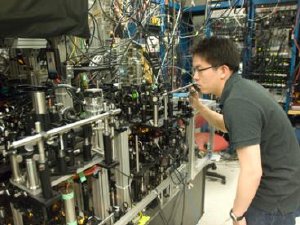Sep 17 2009
For the first time, MIT scientists have observed ferromagnetic behavior in an atomic gas, addressing a decades-old question of whether it is possible for a gas to show properties similar to a magnet made of iron or nickel.
 Graduate student Gyu-boong Jo optimizes the laser beam position on the mirror of the optical setup that produced an ultracold gas of lithium ions. Photo - Patrick Gillooly
Graduate student Gyu-boong Jo optimizes the laser beam position on the mirror of the optical setup that produced an ultracold gas of lithium ions. Photo - Patrick Gillooly
The MIT team observed the behavior in a gas of lithium atoms cooled to 150 billionth of 1 Kelvin above absolute zero (-273 degrees C or -459 degrees F). The work, reported in the Sept. 18 issue of the journal Science, was led by Wolfgang Ketterle, the John D. MacArthur Professor of Physics, and by David E. Pritchard, the Cecil and Ida Green Professor of Physics. If confirmed, the MIT result may enter the textbooks on magnetism, showing that a gas of elementary particles known as fermions does not need a crystalline structure to be ferromagnetic.
For decades, it has been an open question whether it is possible for a gas or liquid to become ferromagnetic. Ferromagnetic materials are those that, below a specific temperature, are strongly magnetized even in the absence of a magnetic field. In common magnets such as iron and nickel that consist of a repeating crystal structure, ferromagnetism occurs when unpaired electrons within the material spontaneously align in the same direction.
Electrons, and also neutrons and protons are elementary particles classified as fermions. Atoms and molecules that consist of an odd number of fermion particles are considered composite fermions. Since all fermions have some properties similar to electrons, they can be used to simulate the behavior of electrons in a ferromagnet. In this work, the researchers studied the fermionic atom lithum-6, which consists of three protons, three neutrons and three electrons.
Just like electrons, these lithium-6 atoms act like little magnets that can align in the same direction under certain circumstances. In nature, fermionic liquids or gases exist as electron gases, in liquid helium-3 and in neutron stars.
"All liquid or gaseous fermion systems in nature don't have strong enough interactions to become ferromagnetic," explains physics graduate student Gyu-Boong Jo, a member of the research team. "But for the lithium atoms, we can use tricks of atomic physics to adjust the interactions between the atoms to arbitrary strength, by simply changing an external magnetic field."
In their experiment, the MIT team trapped a cloud of ultracold lithium atoms in the focus of an infrared laser beam. When they gradually increased the repulsive forces between the atoms, they observed several features indicating that the gas had become ferromagnetic. The cloud first became bigger and then suddenly shrunk. When the atoms were released from the trap, they suddenly expanded faster.
Convincing, but not yet a 'slam dunk'
This and other observations agreed with theoretical predictions for a phase transition to a ferromagnetic state. "The evidence is pretty strong," says Pritchard, "but it is not yet a slam dunk. They started to form molecules and may not have had enough time to develop regions of aligned atoms large enough for us to see."
Ketterle adds that he and his colleagues have many ideas how to study this new form of matter more closely: "One thing is certain: We have made an important discovery, which will advance our understanding of magnetism."
Christophe Salomon, research director at France's National Center for Scientific Research, says the findings provide convincing evidence that fermionic gases display the same type of ferromagnetism found in solid crystal materials. To fully prove the case, he says, "It would be nice to see direct observation of ferromagnetism - that all the spins are parallel."
The MIT research is part of a program studying novel magnetic materials - which have important applications in data storage, nanotechnology and medical diagnostics — and the interplay between magnetism and superconductivity.
The work is a continuation of earlier research on Bose-Einstein condensates, a form of matter in which particles condense and act as one big wave. Ketterle received the 2001 Nobel Prize for the discovery and study of this long-sought new form of matter. "We still use the same refrigerator as we used to study Bose-Einstein condensates," says Ketterle. "But the science is very different. Ten years ago, I would have never thought that I would study magnetism today."
Ketterle and Pritchard are principal investigators in MIT's Research Laboratory of Electronics. In addition to Ketterle, Pritchard and Jo, the MIT team included graduate students Ye-Ryoung Lee and Caleb A. Christensen, postdoctoral associate Jae-Hoon Choi, undergraduate student Tony H. Kim, and Joseph H. Thywissen, visiting professor from the University of Toronto. All MIT researchers are members of the MIT-Harvard Center for Ultracold Atoms.
The MIT research was supported by the National Science Foundation, the Office of Naval Research, through a MURI program, and by the Army Research Office with funds from the DARPA OLE program.